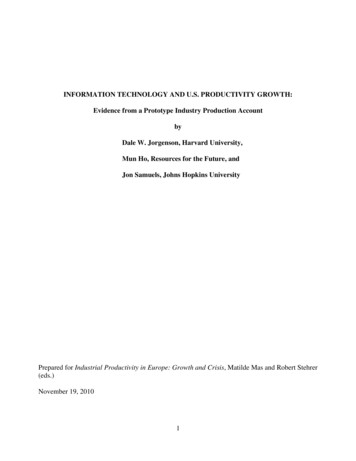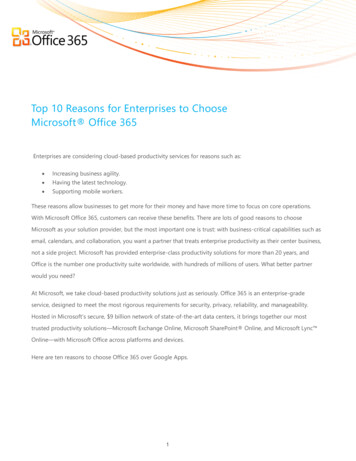
Transcription
Put your phone system on yourcomputer networkfor maximum efficiencyver IP andImplement Voice oy!adotyenomginvstart sasnoitacinummXO Co Use VoIP for yourbusiness phone serviceSee how to get startedwith VoIP, how it works,and why it saves you moneyVoIP is techspeak for “Voice over Internet Protocol,” but itcould also spell “saving big bucks” for your business! Thishandy guide provides the scoop on the hottest advance intelecommunications in plain English. Find out how voicecommunications can travel online and how to choose thebest way to integrate VoIP with your company’s existingsystems. This jargon-free approach helps IT managersunderstand the inner workings of VoIP and explains thebenefits of VoIP features for end-users. Real-world examplesthroughout show how XO Communications can helpcompanies use existing equipment while enjoying thebenefits of the latest VoIP innovations.Simplify networkmanagement withconverged networksIncrease productivitywith VoIP featuresDemonstrate VoIP’sadvantages tomanagementain EnglishExplanations in pl” formation“Get in, get out invigational aidsIcons and other na@Top ten lists Choose from manyA dash of humorand funVoIPA Reference Find listings of all our booksdifferent subject categories Sign up for eTips atfor theRest of Us!FREE eTips at dummies.com etips.dummies.comISBN: 0-470-08640-8XO Part #: BKLTVFD1107Not resaleableWith casestudies on howVoIP improvesproductivityTimothy V. KellyExecutive Director, National Centerfor Converging Technology Research
XO: The Proven Business VoIP ProviderWhat is VoIP?Learn More!Does it really work?Do calls get dropped?Is VoIP calling really free?Before you bet your business communications on VoIP, you need the answers tothese and other critical questions. Who can answer those questions?We’re XO Communications and we sponsored this special edition of VoIP For Dummiesto help answer some of those questions. It can help explain the “what” and the “how”of VoIP. When you’re ready to ask “who?” we hope you’ll turn to XO Communications.XO Communications has been providing communications services exclusively tobusinesses for more than ten years. Our services range from local to long distance, Internet access to private line, Ethernet services, VPN, web hosting, and more. Our VoIPservices provide complete flat-rate solutions for businesses. And, while new VoIP providers are appearing every day, XO is the proven business VoIP provider. And we've gotthe track record to prove it. XO: Has carried VoIP traffic since 2000 Now carries more than 15 billion VoIP minutes per year Serves businesses exclusively, with more than 100,000 businesscustomers Has deployed VoIP service to more than 10,000 businesses and 100,000end users Owns and operates our own award-winning OC 192 IP network backbone Has deployed Sonus softswitches for state-of-the-art IP telephony Carries VoIP traffic for many prominent and emerging VoIP carriersXO serves more than 70 major metropolitan markets nationwide, offers 24 x 7customer care, and a 90-day satisfaction guarantee.So, when it’s time for you to consider the “who” behind your VoIP solution, contactXO Communications.(866) 900-1741www.xo.com/VoIP0-471-77624-6 24.99 272 pagesVoIP For Dummies Look for the full edition wherever books are sold,or visit www.dummies.com
XO Communications VoIPFORDUMmIES‰by Timothy V. Kelly
XO Communications VoIP For Dummies Published byWiley Publishing, Inc.111 River StreetHoboken, NJ 07030-5774www.wiley.comCopyright 2006 by Wiley Publishing, Inc., Indianapolis, IndianaPublished by Wiley Publishing, Inc., Indianapolis, IndianaNo part of this publication may be reproduced, stored in a retrieval system or transmitted in anyform or by any means, electronic, mechanical, photocopying, recording, scanning or otherwise without the prior written permission of the Publisher. Requests to the Publisher for permission shouldbe addressed to the Legal Department, Wiley Publishing, Inc., 10475 Crosspoint Blvd., Indianapolis, IN46256, (317) 572-3447, fax (317) 572-4355, or online at http://www.wiley.com/go/permissions.Trademarks: Wiley, the Wiley Publishing logo, For Dummies, the Dummies Man logo, A Referencefor the Rest of Us!, The Dummies Way, Dummies Daily, The Fun and Easy Way, Dummies.com, andrelated trade dress are trademarks or registered trademarks of John Wiley & Sons, Inc. and/or itsaffiliates in the United States and other countries, and may not be used without written permission.XO Communications, XO, and the XO design logo are trademarks or registered trademarks of XOCommunications, Inc. in the United States and/or other countries. All other trademarks are theproperty of their respective owners. Wiley Publishing, Inc., is not associated with any product orvendor mentioned in this book.LIMIT OF LIABILITY/DISCLAIMER OF WARRANTY: THE PUBLISHER AND THE AUTHOR MAKENO REPRESENTATIONS OR WARRANTIES WITH RESPECT TO THE ACCURACY OR COMPLETENESS OF THE CONTENTS OF THIS WORK AND SPECIFICALLY DISCLAIM ALL WARRANTIES,INCLUDING WITHOUT LIMITATION WARRANTIES OF FITNESS FOR A PARTICULAR PURPOSE.NO WARRANTY MAY BE CREATED OR EXTENDED BY SALES OR PROMOTIONAL MATERIALS.THE ADVICE AND STRATEGIES CONTAINED HEREIN MAY NOT BE SUITABLE FOR EVERY SITUATION. THIS WORK IS SOLD WITH THE UNDERSTANDING THAT THE PUBLISHER IS NOTENGAGED IN RENDERING LEGAL, ACCOUNTING, OR OTHER PROFESSIONAL SERVICES. IF PROFESSIONAL ASSISTANCE IS REQUIRED, THE SERVICES OF A COMPETENT PROFESSIONALPERSON SHOULD BE SOUGHT. NEITHER THE PUBLISHER NOR THE AUTHOR SHALL BE LIABLEFOR DAMAGES ARISING HEREFROM. THE FACT THAT AN ORGANIZATION OR WEBSITE ISREFERRED TO IN THIS WORK AS A CITATION AND/OR A POTENTIAL SOURCE OF FURTHERINFORMATION DOES NOT MEAN THAT THE AUTHOR OR THE PUBLISHER ENDORSES THEINFORMATION THE ORGANIZATION OR WEBSITE MAY PROVIDE OR RECOMMENDATIONS ITMAY MAKE. FURTHER, READERS SHOULD BE AWARE THAT INTERNET WEBSITES LISTED INTHIS WORK MAY HAVE CHANGED OR DISAPPEARED BETWEEN WHEN THIS WORK WAS WRITTEN AND WHEN IT IS READ.For general information on our other products and services, please contact our Customer CareDepartment within the U.S. at 800-762-2974, outside the U.S. at 317-572-3993, or fax 317-572-4002.For technical support, please visit www.wiley.com/techsupport.Wiley also publishes its books in a variety of electronic formats. Some content that appears in printmay not be available in electronic books.ISBN-13: 978-0-470-08640-7ISBN-10: 0-470-08640-8Manufactured in the United States of America10 9 8 7 6 5 4 3 21O/SW/QW/QW/IN
Publisher’s AcknowledgmentsWe’re proud of this book; please send us your comments through our online registrationform located at www.dummies.com/register/. For details on how to create a ForDummies book for your company or organization, please contact dummiesrights&licenses@wiley.com.Some of the people who helped bring this book to market include the following:Acquisitions, Editorial, andMedia DevelopmentProject Editor: Jan WithersEditorial Manager: Rev MengleBusiness Development Representative:Karen HattanComposition ServicesProject Coordinator: Kristie ReesLayout and Graphics: Heather Ryan,Alicia SouthProofreaders: Laura Albert,Dwight RamseySpecial Help: Dave Dobel,Martin WeissPublishing and Editorial for Technology DummiesRichard Swadley, Vice President and Executive Group PublisherAndy Cummings, Vice President and PublisherMary Bednarek, Executive Acquisitions DirectorMary C. Corder, Editorial DirectorPublishing for Consumer DummiesDiane Graves Steele, Vice President and PublisherJoyce Pepple, Acquisitions DirectorComposition ServicesGerry Fahey, Vice President of Production ServicesDebbie Stailey, Director of Composition Services
Table of ContentsIntroduction .1About This Book .1Recognizing the Role of XO Communicationsin VoIP Convergence .2How This Book Is Organized.3Icons Used in This Book.5Where to Go from Here .5Part I: Getting Down to Business with VoIP .7What Is VoIP? .8Understanding How IP Works.10Calling Just About Anywhere with VoIP .11Gaining Flexibility with VoIP.13Part II: Simplified Management with VoIP.17Saving Money with VoIP .18The “Old” Final Four Meet VoIP.20IP Telephony Converges onto the LAN .23One Network versus Three.25Meeting the “New” Future Four.27Protecting Existing Telephony Investments(While Enjoying VoIP Efficiencies) .30Planning Your Future with VoIP .31Part III: Three Phases to VoIP Migration.35Migrating to Converged Communication.35Improving Quality of Service with VoIP .39Part IV: Ten Reasons to Switch to VoIP Now .43Changing Direction of the Telephony Industry.43Feature-Rich, Cost-Effective Alternatives .44Existing Investment Protection .45Flexibility and Portability .45Enhanced Network Management .46Better Utilization of Personnel .46Productivity Applications .47Better Bandwidth Utilization.47
viXO Communications VoIP For DummiesReduced Costs.48Experienced Service from XO .48Part V: Ten VoIP Myths .49VoIP Runs Only on the Internet.50POTS Is Cheaper .50POTS Is Faster .51The Quality of Service Is Suspect .51VoIP-Enabled Phones Are Pricey.52VoIP Calls Can Be Intercepted .52911 Calls May Not Work .53VoIP Isn’t Ready for Prime Time .53VoIP Call Features Are Expensive .54You Have to Discard Your Old Phones .54Case Study: XO Fits Belt Maker’s Need forFaster Communications at Lower Cost.55Determining the Optimal Mix of TelecommunicationsServices .55Replacing Existing Services with an IntegratedVoIP Solution.56Reaping the Rewards: It’s a Cinch.57Appendix: Glossary .59
IntroductionVoIP (pronounced voyp) is the name of a new communications technology that changes the meaning of the phrasetelephone call. VoIP stands for Voice over Internet Protocol, andit means “voice transmitted over a computer network.” VoIPtechnology enables you to merge your current telephoneservice into your data network, thereby reducing costs,simplifying infrastructure, and minimizing maintenance efforts.VoIP gives you greater control, flexibility, and features thatcan make your employees more productive.Internet Protocol (IP) networking is supported by all sorts ofnetworks — corporate, private, public, cable, and even wireless networks. Don’t be fooled by the “Internet” part of theacronym. VoIP will run over any type of network. Currently, inthe corporate sector, the private dedicated network option isthe preferred type. For the telecommuter or home-user, thehands-down favorite is broadband.Traditional telecommunications and Internet Service Providersare racing to provide businesses and residential customerswith VoIP services which, because they are so efficient, arerapidly replacing the traditional services you are used tobuying. In a word, telephony is going digital, and digital meansgetting your infrastructure IP-enabled.As you can imagine, VoIP is a win-win for everyone. The addedflexibility and quicker response times translate into greatercustomer satisfaction and increased productivity throughoutyour organization.About This BookIf you are a manager or owner of a small or medium-sized business who needs to decide whether to make the switch to VoIP,or if you are an IT person looking to help your boss make aninformed decision about integrated networking, this book
2XO Communications VoIP For Dummiesprovides an excellent place for you to begin. It’s also an excellent starting place for end-users who are new to VoIP.With this guide, you can find out how VoIP works and how itsizes up to telecommunications technology that was previously considered to be irreplaceable. By the time you finishPart V, you’ll see why many businesses throughout the worldhave turned to VoIP and integrated networking as their mainsystem for data, voice, and video transfer.You may read this book from cover to cover, which is whatI recommend, seeing as it’s a pretty fast read. If you are in ahurry, however, feel free to dip into whatever part or sectionbest suits your needs and return to the rest of the book whenyou have more time to enjoy the read.Recognizing the Role ofXO Communications inVoIP ConvergenceAs your business experiences convergence — in which voice,data, and Internet services become integrated into a singleservice — you need to make critical decisions that will impactthe cost, efficiency, and productivity of your business. VoIPservices come in a wide range of options, so you want to workwith a proven communications partner that understands bothVoIP technology and your business needs.XO Communications is a recognized leader in VoIP services.XO has built an IP-based, nationwide, fiber-optic network tomeet the communications needs of businesses like yours andcarried over 10 billion minutes on its network last year.Convergence has already started. Service providers areinvesting in the next generation of VoIP services. You canexpect new telecommunications features and services, somenot possible today, to be introduced because of the capabilitiesof an IP-based service. Even today, the benefits are compellingenough that many companies are making the move to VoIPservices now in order to gain productivity and cost savings.
Introduction3How This Book Is OrganizedEach part of this book focuses on a different aspect of VoIP, asdescribed in the following sections. As I mention in the preceding section, you may read the book cover to cover, or skiparound to find the information you need when you need it.Part I: Getting Down toBusiness with VoIPPart I introduces you to the basics of VoIP. You get the rundownon essential terms and the general workings of the technology. This part describes some of the cooler things you can dowith VoIP.Also included is a case study that demonstrates some realworld applications of VoIP.Part II: Simplified Managementwith VoIPIn Part II, you discover how switching to VoIP can reduce youroperating costs — and the effect is immediate. You save thecost of leasing lines and regulatory fees, and calling featuresare actually free.To help set VoIP in context, Part II compares its features andcost structure to the four main non-VoIP telephony models. I’lllet Part II do the talking, but I think you’ll agree after reading itthat VoIP is the most cost-effective choice.All this information is fantastic, but how do you sell it to yourboss? Or, if you are the boss, how do you make the bestinformed decision possible? Look no further. This partgives you all the information you need, including the new“Future Four” ways to make VoIP work for your company.
4XO Communications VoIP For DummiesPart III: Three Phasesto VoIP MigrationPart III outlines the migration path recommended by XO, anindustry-leading vendor of converging technology services.You can also turn to this part to find out how VoIP improvesyour network’s overall quality of service in the course of thetransition. You can also follow the highlights of a case study ofone company that developed a hugely successful VoIP migration strategy.Part IV: Ten Reasons to Switchto VoIP NowThe reasons to switch to VoIP are countless, depending onhow far you want to project the future of the marketplace.Part IV describes the ten best reasons to make the switch. Itcovers everything from projections for the future of thetelephony industry to the flexibility that VoIP features provideyour organization.Part V: Ten VoIP MythsThis part dispels the top ten myths about VoIP. Get the truthabout VoIP here and now.Case StudyThis extended case study illustrates how XO Communicationsadapts its services to make VoIP work for the unique requirements of a multi-location, midsize company. Flip here if youwant to begin with a real-world example of the benefits ofusing VoIP.Appendix: GlossaryConfused by a term you encounter while reading this book?Turn to the glossary and your bewilderment will fade into thepast. (It’s also a great tool for understanding VoIP marketingbrochures and white papers.)
Introduction5Icons Used in This BookThroughout this book, I occasionally use icons to call attention to material worth noting in a special way. Here is a list ofthe icons along with a description of each:If you see a tip icon, perk up — you’re about to find out howto save some aggravation.This icon indicates technical information that is probablymost interesting to IT professionals.Some points bear repeating, and others bear remembering.When you see this icon, take special note of what you’reabout to read.Where to Go from HereThe most important thing to keep in mind whenever you areexploring a new technology is how it fits into the larger picture. Take a global view. Specifically, always be thinking,“How will this feature increase my company’s efficiency?” Or,“How will an integrated network help promote collaborationacross my company?” Of course, you may also be wonderinghow you’ll save money with VoIP.Consider the direction of the telephony industry. The movetoward VoIP is happening, right here, right now. If you are adecision-maker in your company, you need to plan for how youwill remain competitive in this changing market. If you’re an ITprofessional, you need to research the available technologiesso that you can make recommendations to your boss andimplement, if necessary, a VoIP system. End-users need to beprepared to make the switch if their company adopts a VoIPsystem, or if they get transferred to a new location that alreadyhas such a system in place.This book is a great first step to understanding the basics ofVoIP technology. My best advice? Flip the page, and keep onreading!
6XO Communications VoIP For Dummies
Part IGetting Down to Businesswith VoIPIn This Part䊳 How IP Telephony and VoIP work䊳 IP-based features䊳 Getting to know your IP phoneTechnological innovation is hurling itself upon us once again.This time it is coming in the form of improving the way wemake telephone (voice) calls. It brings with it several new capabilities that really change the meaning of the phrase telephonecall. VoIP is the name of this new communications technology.VoIP stands for Voice over Internet Protocol. Basically, VoIPmeans “voice transmitted over a digital network.”VoIP is often referred to as IP Telephony because it uses thelatest innovations with the popular and familiar IP protocols toenable enhanced voice communications throughout the enterprise or small-to-medium-sized business. IP networking supportscorporate, private, public, cable, and even wireless networks. IPTelephony unites an organization’s many locations — includingmobile workers — into a single, converged communicationsnetwork.And by the way, don’t let the “voice” part of the acronym foolyou — IP Telephony calls go above and beyond the call ofduty. When it comes to placing telephone calls, IP Telephonyprovides a range of support services and features unequalledin the world of telephony.
8XO Communications VoIP For DummiesWhat Is VoIP?VoIP, or Voice over Internet Protocol, means basically what theacronym states: Voice travels over the Internet. When VoIPwas first developed, it worked only with the Internet andnothing but the Internet so help us all. Today, VoIP operatesover most distributed network types, including those usedthroughout the corporate sector. But the “I” has stuck withthe acronym. The “P” represents the term Protocol. Protocolrefers to the type of rules that the network uses to send andreceive signals. These signals are the high and low electricalor optical pulses often represented by the more familiar 1sand 0s of digital networking.IP Telephony works by converting voice communications intodata packets. Conveniently, it runs on the popular EthernetLAN (local area network) technology, which currently supports over 96 percent of all company-operated LANs.The old school: Circuit-switchedtelephonyBefore digital networking took off, everyone had to use theone and only Plain Old Telephone Services (POTS). POTS runsover a network called the Public Switched Telephone Network(PSTN). The PSTN has been around since Mr. Bell invented thetelephone. That is why most companies today have POTSrelated systems in place. These POTS telephone systems usethe old tried-and-true method of telephone service known ascircuit-switched.Believe it or not, a good illustration of POTS and PSTN is theexperiment where your fifth-grade teacher had you take twotin cans and a length of wire to create an archaic telephonesystem. As strange as it seems, this antiquated method oftelephony is the principal means underlying the operationof POTS operating over the PSTN.What changes in the real POTS-based telephony system is thenumber, length, diameter, and type of wire or cables used.These elements have grown immensely in variety and type.
Part I: Getting Down to Business with VoIP9In addition, the types of telephone equipment have changeddramatically both at the customer end and at the carrierprovider end. But POTS telephony continues to use “circuitswitched” rules (or protocols) of operation.The new school: Packet-switchedtelephonyUnlike circuit-switched POTS, which always requires use ofthe Public Switched Telephone Network (PSTN), VoIP technology has enabled telephony and other new and novel featuresand services to run over dedicated and wireless networksincluding even your computer network. These newer networktypes use packet-switched protocols.Packet-switched VoIP puts voice signals into packets. Alongwith the voice signals, VoIP packets include both the sender’sand receiver’s network addresses. VoIP packets can traverseany VoIP-compatible network. Along the way, they can choosealternate paths because the destination address is included inthe packet. The routing of the packets is not dependent onany particular network route.In a circuit-switched network, the destination address is notincluded in the signals; routing directions are determinedphysically by the actual POTS line. So the routing must followa specific network line just as a train follows a designated setof railroad tracks. If the line is down, the call cannot gothrough.In a packet-switched distributed network, if one of the network lines supporting the enterprise network is down, thepacket can switch while in route between locations to anotherworking route to keep the call up. Using VoIP, voice signalscan be packetized like computer data packets. This enablescompanies to consider using the same network infrastructureto support both data and voice applications. Companies canconsolidate their physical networks (while maintaining redundancy in their routing patterns) and build an enterprise-classcommunications network with the latest advanced IP-basedfeatures.
10XO Communications VoIP For DummiesVoIP makes possible other services that older telephony systems cannot do. The VoIP protocols, or simply IP as many callit, are interoperable. This term means that the IP protocols willwork well with all kinds of networks. VoIP is valuable becauseit fundamentally operates the same way in all types of networks. IP protocols are also highly portable. This means theywill work with any IP-enabled end-user device such as an IPtelephone, computer, or even a Personal Digital Assistant(PDA). VoIP works everywhere! Because VoIP is interoperableand portable, it makes possible many new end-user applications that redefine how we make telephone calls. BecauseVoIP is highly “networkable,” it is useful to distinguish the twomajor network types used by most if not all companies.Understanding How IP WorksIP Telephony works by taking traditional voice signals and converting them to a form that can be easily transmitted over alocal area network. Thus, the heart of IP Telephony is the sameas traditional data networking with computers. IP-enabledphones handle the voice-to-data conversion well, but don’t bemisled — implementing VoIP doesn’t mean that everyone hasto use IP-enabled phones. The best VoIP providers implementIP Telephony in a manner that protects your investment inexisting telephone equipment, even if you have analog telephone stations.All IP phones have one important thing in common: a built-innetwork interface card (NIC), just like the card a computeruses. The NIC is critical for any network device because it provides the device with a physical address and a way to communicate over the network.The physical address supplied by a NIC is called a MAC address.MAC stands for media access control. The MAC address uses astandardized address, usually represented by six hexadecimalnumbers separated by dashes. For example, the following is avalid MAC address: 00-0A-E4-02-7B-99.To support IP Telephony, a server is typically dedicated to runthe software used to manage calls. Servers are just like personal computers, except they have more memory, speed, andcapacity. The server stores the database that contains all the
Part I: Getting Down to Business with VoIP11MAC addresses corresponding to all the IP telephone extensions assigned to users. Depending on the size of the LAN andthe number of users, you may use more than one server. Forexample, some LANs running IP Telephony dedicate a serverto handle voice mail.Depending on the size of the LAN, one or more devices knownas switches are installed. These switches are boxes that havea series of ports into which all LAN-addressable devicesultimately connect. (Examples of LAN-addressable devicesinclude computers, printers, wireless access devices, gateways, and storage devices.) Usually the switches are set up inthe communications closets around the LAN, and they operate 24 x 7. All the switches are interconnected, often withfiber-optic cable.In a nutshell, all network devices, including your IP telephone,must physically connect to the LAN through a port on a switch.Calling Just About Anywherewith VoIPMaybe ET still can’t call home with VoIP, but you can make IPenabled phone calls as easily as old-fashioned telephone callsand with even greater mobility. The efficiency of IP happensbehind the scenes, as this section explains.Calling on the LANWhen you want to call a coworker at your same location, youdial the phone number corresponding to the person’s name.The signals are packetized and sent to the managing server,where the packet picks up the MAC address of the personyou’re calling. Next, the packet is forwarded to the switch, thento a particular port on that switch, and finally to the IP telephone associated with that MAC address that’s connected tothe port. The coworker’s telephone rings. When the coworkerpicks up the receiver or answers the call, a virtual connectionis established between the coworker and yourself for the lifeof the call. IP Telephony does all this at lightning speed.
12XO Communications VoIP For DummiesCalling on the WANThe process of calling a coworker at an offsite location variesonly a little from calling on the LAN. The call is still initiated inthe same way. But because the coworker is connected to a different LAN, the local server sends the call packets to a specialgateway switch located on your LAN which sends your callthrough the company’s WAN (wide area network) to thedestination LAN and telephone. This is where IP Telephonytechnically becomes VoIP.Each LAN in a multilocation network is connected to thelarger WAN. If you’re located at the company’s headquartersin Pittsburgh, and you call a coworker located at the office inLos Angeles, your call begins as an IP Telephony call on yourLAN. It then travels from your LAN through a gateway, switch,or router that is programmed to repacketize your call andencode the VoIP packet with additional information, such asthe address for the destination LAN.Network gurus refer to the process of packetizing your voicetelephone call as encapsulation. A good analogy for this fancytechno-term is putting a letter into an envelope for mailing.The difference is th
Our VoIP services provide complete fl at-rate solutions for businesses. And, while new VoIP pro-viders are appearing every day, XO is the proven business VoIP provider. And we've got the track record to prove it. XO: Has carried VoIP traffi c since 2000 Now carries more than 15 billion VoIP minutes per year











